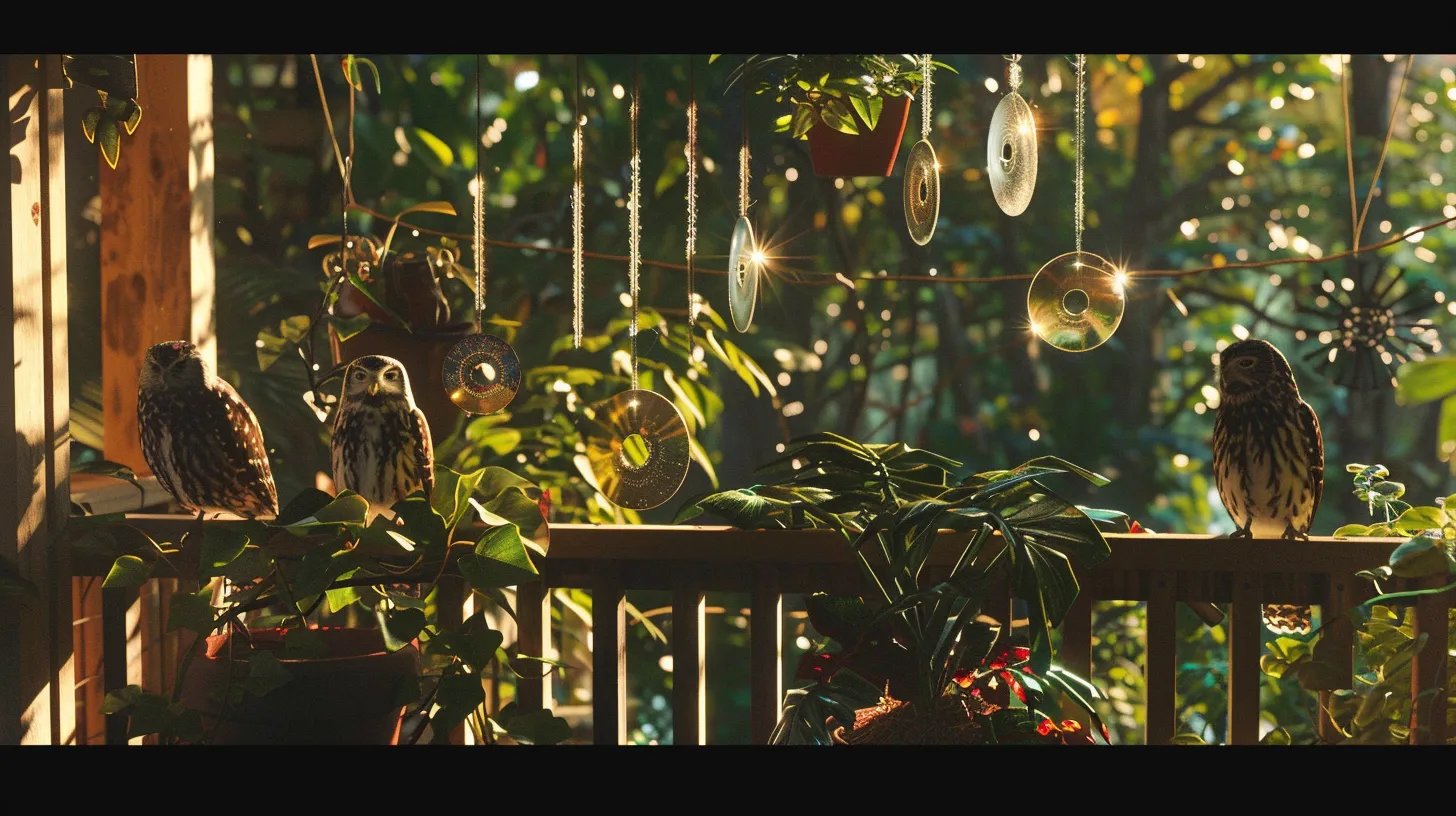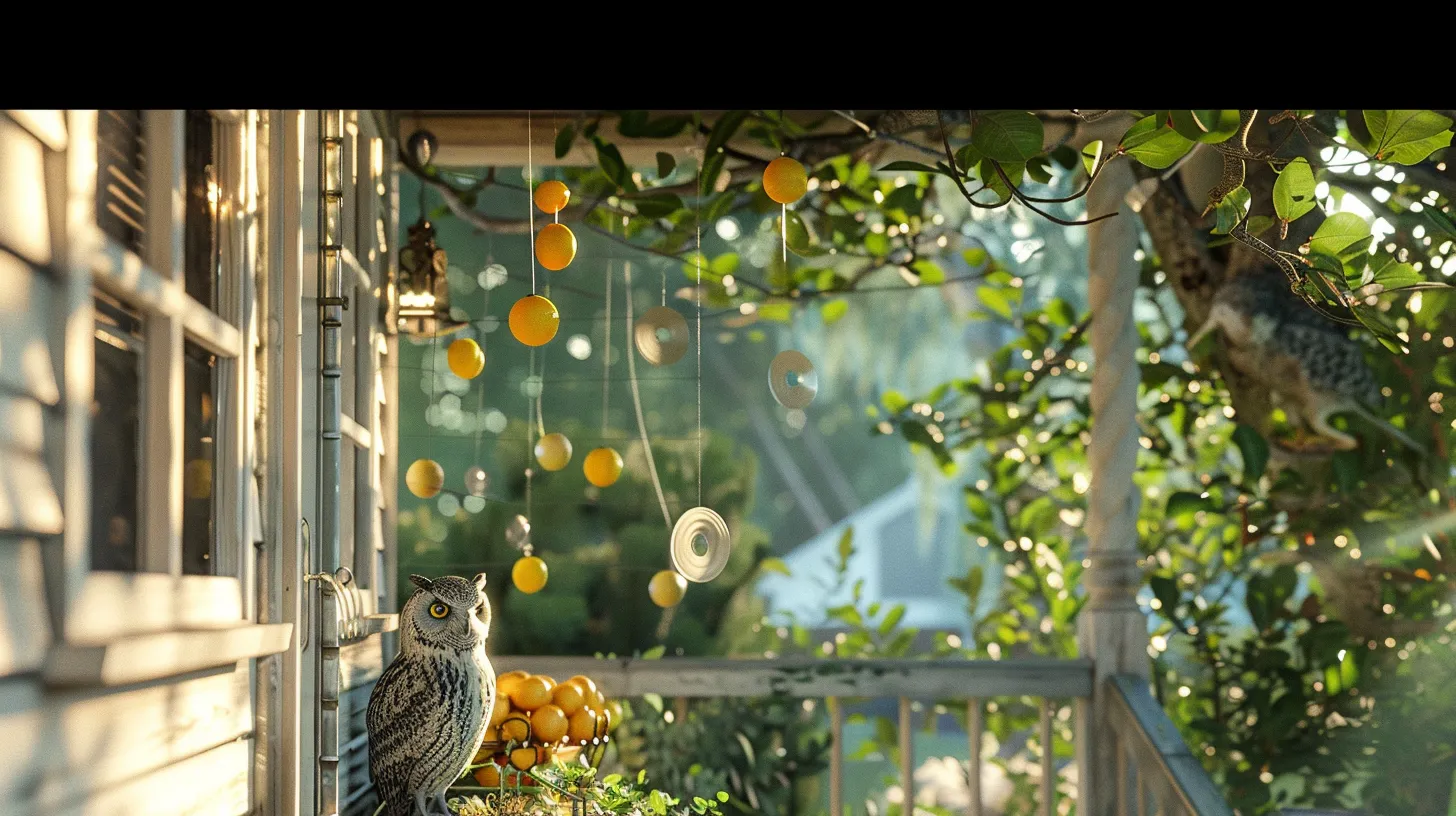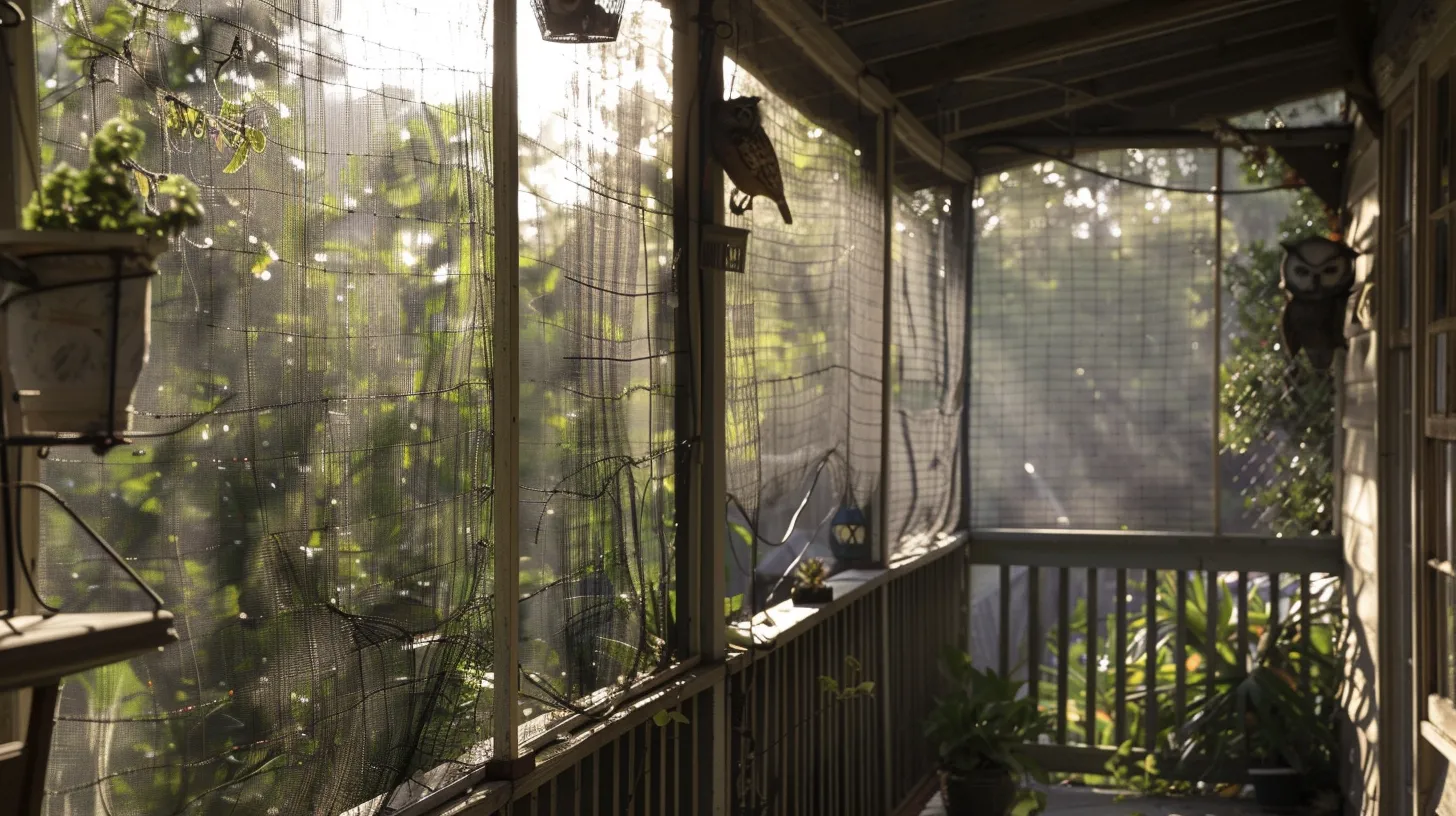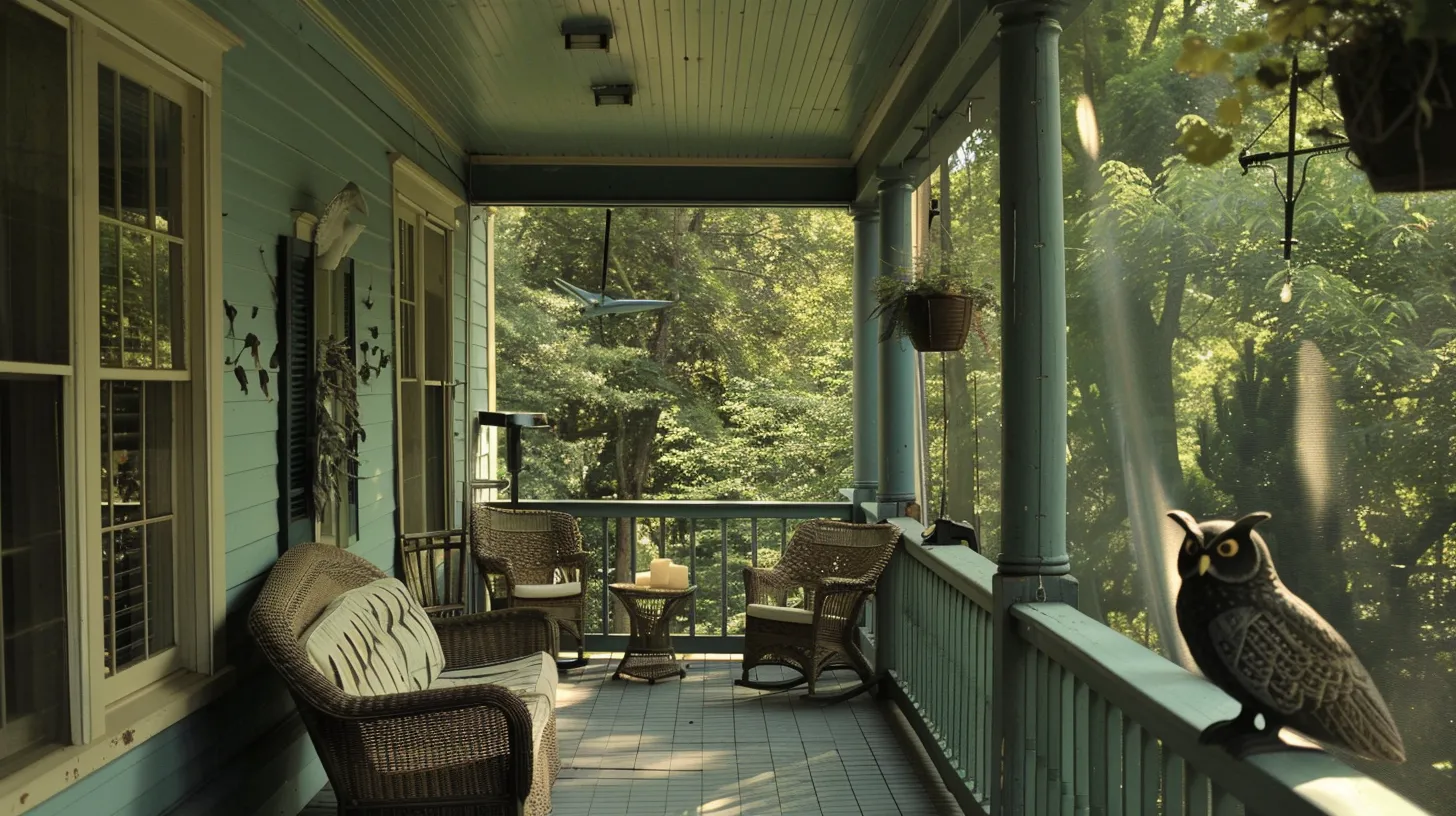To effectively deter birds and prevent them from soiling your porch, employ a combination of strategies tailored to disrupt their habitual behavior. Reflective materials and visual deterrents such as CDs or decoys create confusion and fear. Utilize natural deterrents like lavender and marigold or chemical solutions including citrus-scented sprays to create an unwelcome environment. Incorporating physical barriers , such as bird spikes and netting, prevents perching and roosting. Additionally, maintaining cleanliness and managing outdoor furniture plays a significant role. Combining these methods enhances efficacy and maintains the aesthetic appeal of your space. There's much to explore in enhancing these strategies for best results.
Understanding Bird Behavior

To effectively deter birds from your porch, it is essential to first understand their behavior and habits. Recognizing that birds are creatures of habit can guide the implementation of effective deterrent strategies. For instance, birds are often disoriented by unfamiliar or hostile environments. Utilizing reflective materials such as aluminum foil, or installing predator decoys , can exploit this trait by creating an unwelcoming area for birds to land and linger.
In addition to visual deterrents, sonic sounds can be employed to disrupt the comfort birds find in their usual roosting spots . These sounds mimic predator calls or generate unpleasant noises, making the porch an undesirable location for birds. Additionally, the strategic use of baking soda on railing surfaces where birds typically perch discourages them due to its texture and feel under their feet.
Eliminating attractants is also important. Make sure that all possible food sources , including pet food and water bowls, are removed. This absence of resources contributes to creating a bird-free porch by signaling that the area does not support their basic needs , thus encouraging them to move to more hospitable environments. By combining these approaches, homeowners can effectively discourage bird presence and maintain a clean, welcoming porch space.
Natural Deterrent Techniques

Building on our understanding of bird behavior, exploring natural deterrent techniques offers additional, environmentally friendly options to keep birds away from your porch. One effective strategy is the planting of bird-deterring plants . Species such as lavender and marigold not only beautify your space but also naturally repel birds due to their strong scents.
Additionally, hanging reflective objects such as old CDs or small mirrors can create visual distractions that confuse and deter birds from approaching your porch. The reflections disrupt their sense of security and encourage them to seek more stable environments.
Applying natural oils or vinegar to the areas where birds frequently perch can also serve as potent deterrents. These substances create an unpleasant environment for birds due to their strong odors. Similarly, incorporating decoys like fake predators or scarecrows can make your porch appear dangerous to birds. Models of owls, hawks, or even simple scarecrows can effectively keep birds at bay.
Furthermore, adding elements like bunting or windmills can enhance these visual distractions. The movement and colors of bunting and the spinning action of windmills add another layer of deterrence, making the porch less attractive to our feathered friends.
Setting Up Physical Barriers

Physical barriers such as bird spikes , netting , and fencing serve as effective deterrents, preventing birds from perching on your porch railing. These deterrents are designed to create an uncomfortable surface that makes it unappealing for birds to land or roost, thereby helping to maintain a clean outdoor space .
Bird spikes, in particular, can be installed along the railing in a way that is vital and minimally invasive to the aesthetic of the porch. Available in materials like rubber, plastic, or metal, bird spikes offer flexibility in matching the design and decor of your home while still serving as a robust long-lasting solution to bird problems. By choosing the appropriate material, homeowners can make sure that the spikes integrate well with their existing structures without standing out excessively.
The installation of these physical barriers not only helps to prevent birds from perching but also discourages them from returning, providing a sustainable and effective method to keep your porch clean and free from bird droppings . Therefore, setting up physical barriers like bird spikes proves to be an essential step in protecting your porch railing and enhancing the overall enjoyment of your outdoor living space.
Implementing Chemical Solutions

While physical barriers are a robust method for deterring birds, implementing chemical solutions offers an additional layer of protection to keep them away from your porch. Bird repellent sprays with citrus scents serve as an effective chemical deterrent, leveraging the aversion birds have to these aromas. Regular application of these sprays is vital; their effectiveness in creating a hostile environment for birds diminishes without consistent use, thereby increasing the likelihood of birds perching on your porch.
Additionally, the use of baking soda , another chemical solution, can be strategically applied to areas where birds are likely to land. This not only prevents them from settling but also maintains the aesthetic and functional aspects of your porch.
For both bird repellent sprays and baking soda, it is important to adhere to product guidelines to guarantee safe usage . These guidelines provide critical information on the proper handling and application methods that maximize effective deterrence while maintaining safety for both humans and the environment. By following these prescribed practices, you can maintain a bird-free porch effectively and safely, ensuring a pleasant outdoor space.
Proper Outdoor Furniture Management

Effective management of outdoor furniture is essential for creating a bird-free environment on your patio or garden. Incorporating strategic outdoor furniture management tactics can greatly reduce the likelihood of avian nuisances. One effective approach involves the use of decoys that mimic natural predators . Placing these figures near seating areas can discourage birds from approaching, as they perceive a threat to their safety.
Additionally, maintaining patio cleanliness is important. Regular cleaning of surfaces and removal of bird droppings diminish the attractiveness of the area to birds. This practice not only deters birds but also maintains the aesthetic and hygienic quality of the outdoor space.
Another important aspect is the removal of bird attractants . Make sure that food remnants and water containers are cleared promptly to avoid drawing birds to the furniture. Similarly, using repellents can further enhance the effectiveness of these measures by creating an unpleasant environment for birds.
Lastly, physical barriers such as netting provide a direct method to prevent birds from accessing the furniture. Covering furniture when not in use can also protect it from droppings and reduce cleaning time, ensuring that your outdoor area remains pristine and welcoming for human use, free from avian intruders .
Innovative Visual Repellents

To deter birds effectively, homeowners can employ several innovative visual repellents in their outdoor spaces. Among these, reflective spinners and discs are particularly useful. When hung around the porch, these items generate visual distractions due to their light-reflecting and spinning properties , which can effectively scare off birds and prevent them from settling on surfaces.
Plastic owls, as another example, serve as versatile deterrents. Their lifelike appearance can fool birds into thinking a predator is present, thereby keeping them away from your porch. Strategically placing these owls can enhance their effectiveness and maintain a bird-free zone.
Additionally, the use of plastic snakes in garden beds or near the porch adds a layer of deterrence. These mimic natural predators of birds , leveraging the birds' instinctual fears to keep them at bay.
Another innovative approach involves the color of your porch ceiling. Painting it haint blue , a light blue shade that mimics the sky, can deter birds from roosting. It's beneficial to test different paint colors to find the most effective deterrent, as the specific shade can greatly influence the repelling efficacy .
Together, these deterrents provide a thorough approach to keeping birds away from your porch, combining aesthetics with functionality.
Effective Sound Strategies

In addition to visual deterrents , sound strategies offer an additional layer of defense against birds perching on your porch. Employing a variety of noise-making devices like wind chimes and ultrasonic devices can be highly effective. These sound deterrents work by creating an auditory environment that is unpleasant for birds, thereby preventing them from roosting and leaving droppings.
Installing motion-activated sound devices adds an element of surprise that can startle birds, disrupting their habituation to the area. The sudden bursts of noise make the porch less attractive for lingering or nesting. In addition, the use of bird distress calls plays a critical role in bird control. These calls, emitted through strategically placed speakers, mimic the sounds of birds in distress, signaling danger to other birds and encouraging them to flee to safer locations.
Integrating these innovative strategies into your bird deterrent regimen can greatly enhance the effectiveness of keeping birds away. By combining sound-based bird deterrents with other methods, you create a multi-sensory barrier that is more difficult for birds to adapt to, ensuring your porch remains clean and free from unwanted avian visitors .










